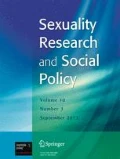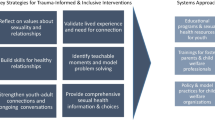Abstract
Introduction
US foster youth have elevated pregnancy and sexually transmitted infection (STI) rates, yet receive limited sexual health education and intervention. Thus, we sought to co-develop a comprehensive model of sexual health needs among youth in foster care group homes through a community-engaged research process with foster youth and foster care staff to inform such intervention.
Methods
Our team conducted five in-depth focus groups with both foster youth placed in group homes and foster care staff (social workers and group home staff) in 2018–2019. We analyzed the data through iterative open, focus, axial, and selective/theoretical coding using constructivist grounded theory (GT) methods to produce a model of sexual health needs among youth in foster care group homes.
Results
GT analysis revealed the model’s core category, Addressing Sexual Health among Youth in Foster Care Group Homes, has three supporting categories: reproductive health system, relationship health, and mental health.
Conclusions
The study model offers new pathways for comprehensively addressing sexual health and well-being in this specialized population, grounded in foster youth and staff members’ direct, lived experiences.
Policy Implications
This conceptualization expands current intervention options beyond pregnancy/STI education programs alone to a holistic, multilevel focus on the interrelated need for trauma-informed family planning and contraception care, mental health and substance use care, sexual and emotional safety, and healthy relationships.

Similar content being viewed by others
References
Ahrens, K. R., McCarty, C., Simoni, J., Dworsky, A., Courtney, M. E. (2013). Psychosocial pathways to sexually transmitted infection risk among youth transitioning out of foster care: Evidence from a longitudinal cohort study. Journal of Adolescent Health, 53(4), 478–485.
Ahrens, K. R., Richardson, L. P., Courtney, M. E., McCarty, C., Simoni, J., Katon, W. (2010). Laboratory-diagnosed sexually transmitted infections in former foster youth compared with peers. Pediatrics, 126(1).
Ahrens, K. R., Spencer, R., Bonnar, M., Coatney, A., & Hall, T. (2016). Qualitative evaluation of historical and relational factors influencing pregnancy and sexually transmitted infection risks in foster youth. Children and Youth Services Review, 61, 245–252. https://doi.org/10.1016/j.childyouth.2015.12.027
Aparicio, E., Pecukonis, E. V., & O’Neale, S. (2015). “The love that I was missing”: Exploring the lived experience of motherhood among teen mothers in foster care. Children and Youth Services Review, 51, 44–54. https://doi.org/10.1016/j.childyouth.2015.02.002
Aparicio, E. M., Shpiegel, S., Grinnell-Davis, C., & King, B. (2019). “My body is strong and amazing”: Embodied experiences of pregnancy and birth among young women in foster care. Children and Youth Services Review, 98, 199–205. https://doi.org/10.1016/j.childyouth.2019.01.007
Charmaz, K. (2014). Constructing grounded theory. Thousand Oaks, CA: Sage.
Combs, K. M., Aparicio, E. M., Prince, D. M., Grinnell-Davis, C., Marra, L., Faulkner, M. (2019). Evidence-based sexual health programs for youth involved with juvenile justice and child welfare systems: Outcomes across settings. Children and Youth Services Review, 100, 64–69.
Font, S. A., Cancian, M., Berger, L. M. (2019). Prevalence and risk factors for early motherhood among low-income, maltreated, and foster youth. Demography, 56(1), 261–284.
Harmon-Darrow, C., Burruss, K., & Finigan-Carr, N. (2020). “We are kind of their parents”: Child welfare workers’ perspective on sexuality education for foster youth Children and Youth Service Review, 108, 104565. https://doi.org/10.1016/j.childyouth.2019.104565
Kachingwe, O. N., Salerno, J. P., Boekeloo, B. O., Fish, J. N., Geddings-Hayes, M., Aden, F., Aparicio, E. M. (2020). “The internet is not private”: The role of social media in sexual health among youth in foster care. Journal of Adolescence, 82, 50–57. https://doi.org/10.1016/j.adolescence.2020.06.005
King, B., Eastman, A. L., Grinnell-Davis, C., & Aparicio, E. (2019). Early Childbirth Among Foster Youth: A Latent Class Analysis to DetermineSubgroups at Increased Risk: Early Childbirth among Foster Youth. Perspectives on Sexual and Reproductive Health. https://doi.org/10.1363/psrh.12124
Oman, R. F., Vesely, S. K., Green, J., Clements-Nolle, K., Lu, M. (2018). Adolescent pregnancy prevention among youths living in group care homes: A cluster randomized controlled trial. American Journal of Public Health, 108(S1), S38–S44.
Oman, R. F., Vesely, S. K., Green, J., Fluhr, J., & Williams, J. (2016). Short-Term Impact of a Teen Pregnancy-Prevention Intervention Implemented inGroup Homes. Journal of Adolescent Health, 59(5), 584–591. https://doi.org/10.1016/j.jadohealth.2016.07.002
Salerno, J. P., Kachingwe, O. N., Fish, J. N., Parekh, E., Geddings-Hayes, M., Boekeloo, B. O., Aparicio, E. M. (2020). “Even if you think you can trust them, don’t trust them”: An exploratory analysis of the lived experiences of sexual health among sexual minority girls in foster care. Children and Youth Services Review, 116, 105161. https://doi.org/10.1016/j.childyouth.2020.105161
Sedgh, G., Finer, L. B., Bankole, A., Eilers, M. A., Singh, S. (2015). Adolescent pregnancy, birth, and abortion rates across countries: Levels and recent trends. Journal of Adolescent Health, 56(2), 223–230.
Shpiegel, S., & Cascardi, M. (2015). Adolescent parents in the first wave of the National Youth in Transition Database. Journal of Public Child Welfare, 9(3), 277–298.
Slade, A., Narro, A. J., Buchanan, B. P. (Eds.). (2014). Reality television: Oddities of culture.
Stephens, T., & Aparicio, E. M. (2017). “It’s just broken branches”: Child welfare-affected mothers’ dual experiences of insecurity and striving for resilience in the aftermath of complex trauma and familial substance abuse. Children and Youth Services Review, 73, 248–256. https://doi.org/10.1016/j.childyouth.2016.11.035
Trickett, P. K., Noll, J. G., & Putnam, F. W. (2011). The impact of sexual abuse on female development: Lessons from a multigenerational, longitudinal research study. Development and Psychopathology, 23(2), 453–476. https://doi.org/10.1017/S0954579411000174
Winter, V. R., Brandon-Friedman, R. A., Ely, G. E. (2016). Sexual health behaviors and outcomes among current and former foster youth: A review of the literature. Children and Youth Services Review, 64, 1–14.
Acknowledgments
We are deeply grateful to our study participants for sharing their experiences, to our community partner Hearts and Homes for Youth, and Hearts and Homes for Youth staff, who made this research possible, and to the journal reviewers and editors for helping us to strengthen earlier versions of this manuscript. This work was supported by the University of Maryland Department of Behavioral Health and the University of Maryland Prevention Research Center cooperative agreement #U48DP006382 from the Centers for Disease Control and Prevention (CDC). Any interpretations and opinions expressed herein are solely those of the authors and may not reflect those of the CDC.
Funding
University of Maryland Department of Behavioral and Community Health and US Centers for Disease Control and Prevention.
Author information
Authors and Affiliations
Corresponding author
Ethics declarations
Informed Consent
Informed consent was provided by each study participant.
Ethical Approval
This study was approved by the University of Maryland Institutional Review Board.
Additional information
Publisher’s Note
Springer Nature remains neutral with regard to jurisdictional claims in published maps and institutional affiliations.
Rights and permissions
About this article
Cite this article
Aparicio, E.M., Kachingwe, O.N., Salerno, J.P. et al. Addressing Sexual Health Among Youth in Foster Care Group Homes: A Community-Engaged Grounded Theory Study. Sex Res Soc Policy 18, 1136–1147 (2021). https://doi.org/10.1007/s13178-020-00519-w
Accepted:
Published:
Issue Date:
DOI: https://doi.org/10.1007/s13178-020-00519-w



